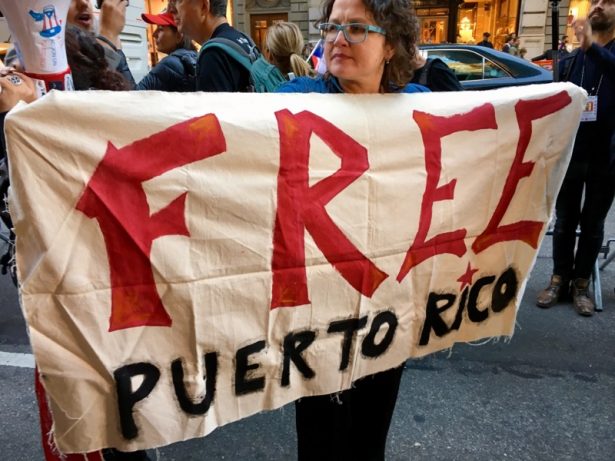
On 20 September Category 4 Hurricane Maria hit the US colony of Puerto Rico destroying the power grid, all agriculture and non-concrete structures. Hurricanes Irma and Maria, the tenth worst Atlantic hurricane, caused catastrophic damage to infrastructure, and hundreds of deaths across the Caribbean. Officially 48 people were killed but the real death toll is probably 10 times that, closer to 450 people, according to a report by Eliza Barclay (Vox.com). There are over 25 sites with hazardous waste throughout the island, which has now spread due to flooding.
One month later, three million people are still without electricity – 80% of the population. Basic supplies like food and water in some areas are in short supply. More than a third of households are still without reliable drinking water, affecting roughly one million people. It could take up to 6 months to restore services. There is little access to cellular, cable, and Internet service.
The US government has been very slow to help the people of Puerto Rico, and has dragged its feet (liberationnews.org). No significant aid has made it to the island, despite donations from Cuba, Mexico, Venezuela and the Puerto Rican diaspora. After complaining on 26 September that Puerto Rico was ‘an island sitting in the middle of an ocean … a very big ocean,’ President Donald Trump reluctantly but temporarily waived the Jones Act allowing foreign aid ships to dock in Puerto Rico for only ten days.
The Jones Act, officially the 1920 Merchant Marine Act, requires all goods transported between US ports to be carried on US-built, owned and crewed ships. It severely limits the number of ships which can transport goods to Puerto Rico, and increases the price of shipping to the island. It was an attempt to avoid repetition of the shipping shortages that occurred in World War 1, when lack of access to foreign shippers left the US military without the means to move men and materiel to the war zone (Loren Thompson, Forbes.com). It helps the imperialists maintain a sizable fleet of US commercial vessels, available for military use, and protects commercial vessels from foreign competition.
Trump had quickly waived the Jones Act for areas of Texas affected by Hurricane Harvey. The massive emergency medical ship, USNS Comfort, wasn’t sent out until two weeks after the storm. People outside San Juan, the capital, haven’t seen any aid officials from Federal Emergency Management Administration (FEMA). Congress has only approved $37 billion in emergency aid for FEMA and other emergency agencies, for western US states affected by devastating wildfires, and all the hurricane disasters, including for Texas and the Gulf Coast, for Florida and Puerto Rico combined. A pitiful sum. Trump has blamed ‘corruption on the island’ and given himself ten out of ten for his efforts.
Nevertheless electricity and water is gradually being restored for Puerto Rico’s real assets – its colonial role as a source of pharmaceutical products for the United States. Pharmaceuticals represented 72% of Puerto Rico’s 2016 exports, valued at $14.5 billion. Puerto Rico makes up 25% of total US pharmaceutical exports (FiercePharma.com). Puerto Rico is the base for about 50 FDA-approved drug making facilities, including facilities owned by some of the largest pharmaceutical corporations, like British giant AstraZeneca, Pfizer, Merck & Co, Eli Lilly, Bristol-Myers Squibb, Amgen and Johnson & Johnson’s Janssen. About 40 drugs, 13 of them exclusively, are manufactured in Puerto Rico. There are ‘no therapeutic substitutes for these drugs’. These sites all have back-up generators up and running. The Food and Drug Administration (FDA) has made sure fuel has been supplied to Big Pharma.
Big Pharma are not the only parasites or vultures circling and feeding off Puerto Rico’s humanitarian catastrophe. US banks and financial corporations see this as an opportunity to socially cleanse and privatise the colony, just as after Hurricane Katrina in New Orleans in 2005. Trump voiced this desire when he claimed in a series of tweets that Puerto Rico ‘owed billions of dollars to Wall Street and the banks which, sadly, must be dealt with.’
There is now also a massive liquidity crisis, with hurricane damages of $95 billion, 150% of GNP, for an already broke island. Puerto Rico is being financially strangled by a $72 billion debt fuelled by corrupt British and US banks, and Puerto Rico’s inability to pay led the US to pass the Puerto Rico Oversight Management and Economic Stability Act (PROMESA) in June 2016 which created a Fiscal Control Board to manage the islands finances and squeeze funds out of Puerto Rico. A series of reports by ReFund America Project has shown that predatory Wall Street banks like UBS, Goldman Sachs and Citigroup, as well as British company Barclays Capital have raked in billions of dollars in fees alone from arranging and rearranging Puerto Rico debts. Since 2000, Puerto Rico has been taking out debts simply to fill budget gaps, ‘refunding’ its debts by issuing new bonds to push current debt payments into the future, kicking the can down the road, and paying ‘issuance fees’ for each new borrowing. Puerto Rico has also been paying ‘capitalising interest’ which essentially means paying interest on interest -a practice that doesn’t provide any net benefit to Puerto Rico but simply generates fee income for the banks. According to ReFund America Project, $36.7 billion of this is ‘illegitimate debt’ and should be cancelled by the Fiscal Control Board.
US exploitation of its colony Puerto Rico has made it impossible for the island to respond meaningfully to the natural disasters having been bled dry of resources for decades. Unlike socialist Cuba, Puerto Rico doesn’t have the social system, preventive measures or control of its own territory and resources, nor even the ability to receive solidarity aid, to help its people recover from this disaster.
Repeal the colonial Jones Act!
Cancel all the debts!
US imperialism out of Puerto Rico!




